The carving is done on the section of the key that is cranked sideways. My keys came with pencil lines already drawn at the two "joints." I added another line that is 1/4" inside of those two lines. Rather than measure each and every line, I constructed a cardboard template that was the required width and worked through the keys individually by laying that template against the supplied pencil lines and drew. It might have been quicker to put all the keys back on the rack and draw one long line with a straight edge, but to be honest, I just didn't think of it.
Next, I drew a north-south line down the center of each key, connecting those horizontal lines. I eyeballed two center points (I'm very good at that) and used a straight edge to draw.
And finally, I made another template, this one 3/16" and used it to draw a line on the two sides of each key. I had some trouble wrapping my mind around that step, but the ah-ha moment arrived as sleep escaped me in the wee hours. Here's a typical key with all the lines drawn.
The idea, as I understand it, is to carve the wood from the side lines up to that center line and create a profile similar to a pointed roof. I'm still puzzling over that quarter-inch edge at the top and bottom. It has been described as similar to the tip of a ski. Perhaps it will become clear as I'm drifting off tonight.
This whole undertaking promises to be quite an endeavor. Wish me luck!















